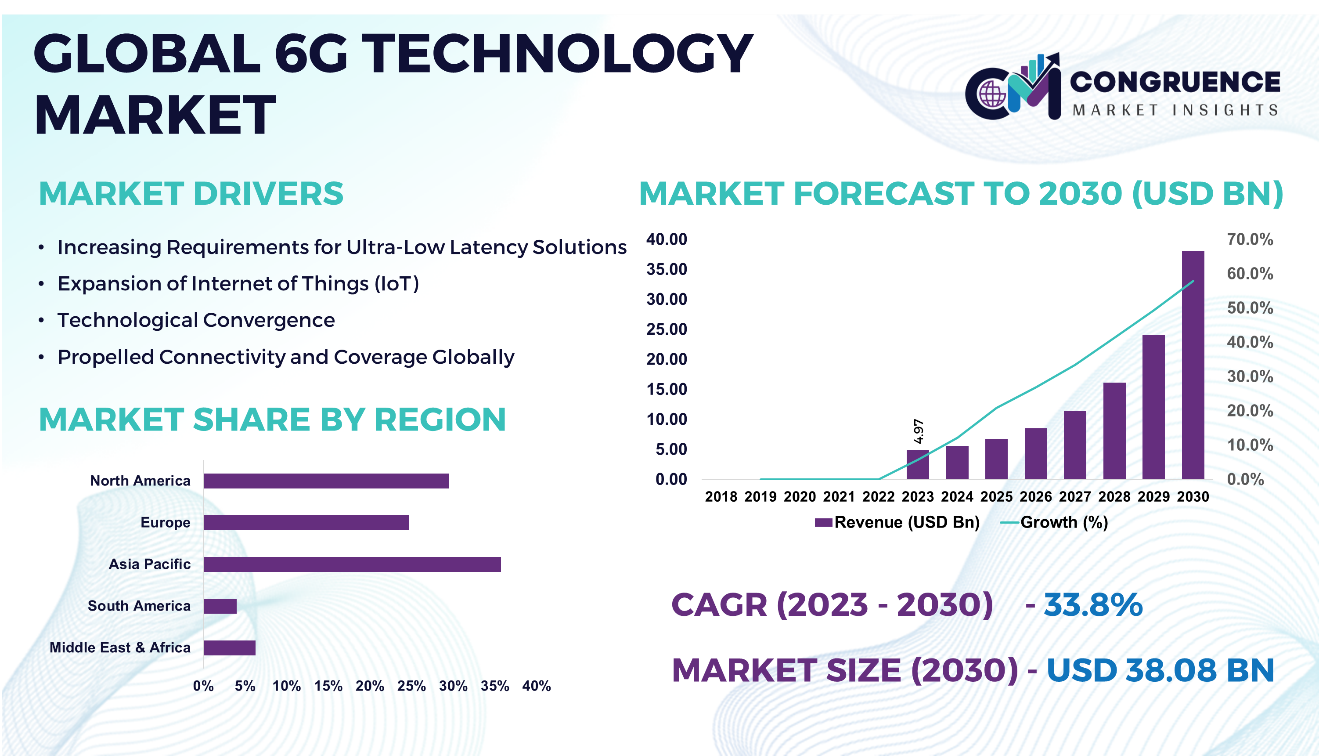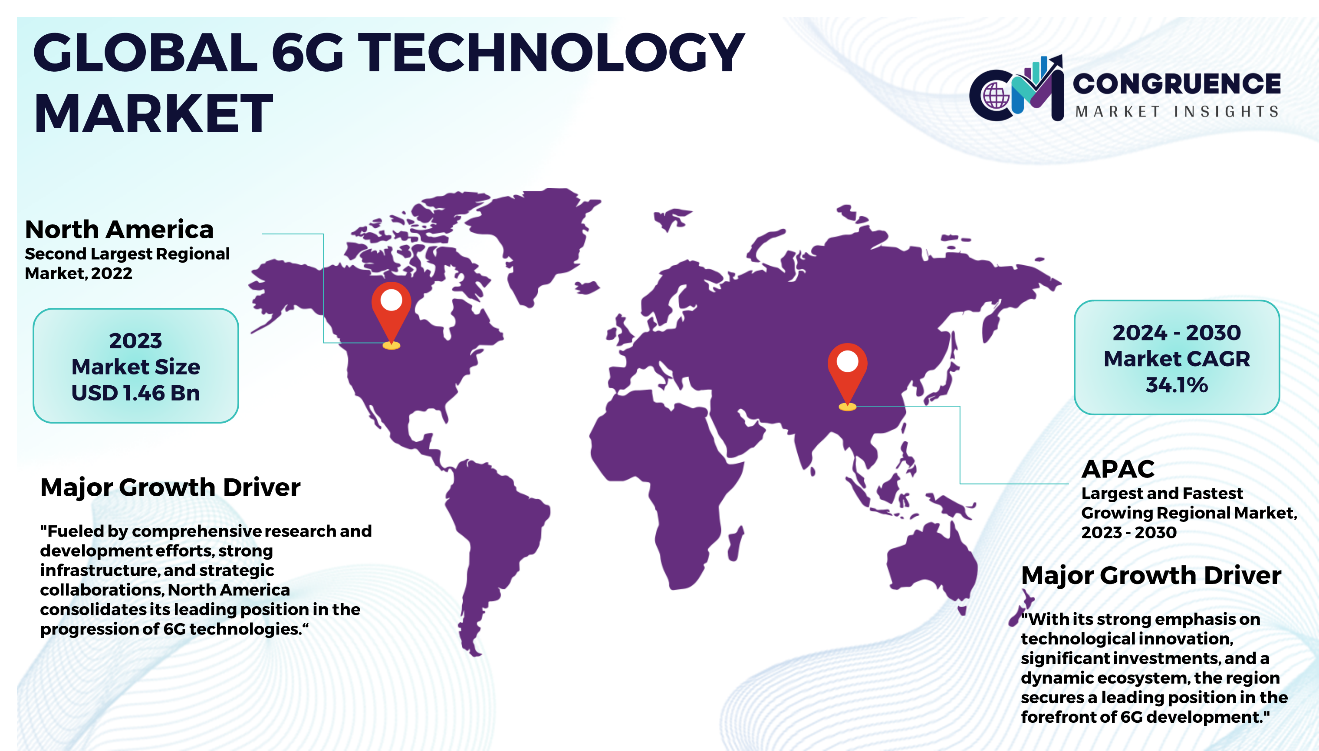Reports
The Global 6G Technology Market was valued at USD 4.97 Billion in 2023 and is anticipated to reach a value of USD 38.08 Billion by 2030 expanding at a CAGR of 33.8% between 2023 and 2030.
The 6G technology market stands at the cusp of transforming wireless communication, ushering in an era marked by unparalleled connectivity and capabilities as the natural successor to 5G. Envisioned to usher in a remarkable surge in data speeds, reduced latency, and heightened network capacity, 6G is poised to unleash transformative applications spanning various industries. At its essence, the market introduction of 6G is characterized by the exploration of state-of-the-art infrastructure, networks, and bandwidth. The foundational infrastructure comprises a dense network of small cells, massive MIMO antennas, and inventive backhaul solutions, laying the groundwork for a highly interconnected and intelligent network capable of supporting a spectrum of applications. From enhanced mobile broadband to ultra-reliable low-latency communications and massive machine-type communications, the 6G network is designed to cater to diverse needs. Leveraging technologies such as terahertz frequencies for heightened data rates and improved reliability, 6G networks are crafted to provide seamless connectivity. The strategic integration of artificial intelligence (AI) assumes a pivotal role in optimizing network performance and dynamically allocating resources. Furthermore, 6G's exploration of novel frequency bands, including terahertz frequencies, delineates its bandwidth capabilities. This increased bandwidth not only speeds up data transmission but also lays the foundation for accommodating a wide range of connected devices, opening the door to the Internet of Things (IoT) on an unprecedented scale. To sum up, the 6G technology market marks the dawn of a new era in connectivity, pushing the boundaries of what is possible in wireless communication. With advanced infrastructure, intelligent networks, and expanded bandwidth, 6G is poised to reshape the possibilities of communication technology and foster innovations across industries.

6G Technology Market Major Driving Forces
Increasing Requirements for Ultra-Low Latency Solutions: Essential applications like augmented reality, virtual reality, autonomous vehicles, and real-time communications necessitate ultra-low latency. In response, 6G is poised to meet these stringent requirements, ensuring near-instantaneous response times for critical applications.
Expansion of Internet of Things (IoT): The widespread adoption of IoT devices across diverse industries necessitates resilient, scalable, and low-power connectivity. Anticipated as a catalyst for the exponential growth of IoT ecosystems, 6G is expected to provide support for a vast array of connected devices.
Technological Convergence: The amalgamation of diverse technologies, encompassing artificial intelligence, edge computing, and advanced wireless communication, serves as a driving force propelling 6G forward. The integration with AI is poised to optimize network performance and empower intelligent applications.
Propelled Connectivity and Coverage Globally: A pivotal challenge tackled by 6G involves ensuring global connectivity and coverage. Collaborations with satellite communication systems and advancements in network architecture are anticipated to contribute significantly to achieving comprehensive coverage.
6G Technology Market Key Opportunities
Revolutionizing Industrial Connectivity: The introduction of 6G provides an avenue to deliver highly dependable and low-latency connectivity tailored to the specific requirements of industries such as manufacturing, healthcare, and logistics. This opens the door to significant advancements in industrial automation, remote surgery, and real-time monitoring.
Immersive AR and VR Experiences: 6G's capabilities create unprecedented opportunities for immersive experiences in augmented reality (AR) and virtual reality (VR). This fosters applications in gaming, education, training, and simulations, fundamentally transforming user interactions with digital content.
Transformative Healthcare Services: The ultra-reliable and low-latency communication offered by 6G has the potential to revolutionize healthcare services, enabling remote surgeries, telemedicine, and real-time patient monitoring. This creates opportunities for enhanced accessibility and efficiency in healthcare delivery.
Real-Time Holographic Communication: The potential for real-time, high-quality holographic communication creates opportunities for more immersive and interactive remote collaboration in business, education, and entertainment spheres.
6G Technology Market Key Trends
· A prominent trend in 6G development is the exploration of terahertz frequencies for wireless communication. These extremely high frequencies offer the potential for significantly increased data rates and bandwidth, paving the way for ultra-fast and efficient connectivity.
· Artificial intelligence (AI) plays a central role in 6G networks, contributing to dynamic resource allocation, network optimization, and intelligent decision-making.
· The development of real-time, high-quality holographic communication is gaining traction as a trend in 6G. This technology holds the potential to revolutionize remote collaboration in various sectors.
· The standardization of 6G is marked by a trend of global collaboration. Industry stakeholders, research institutions, and international organizations are working together to establish common standards that facilitate interoperability and widespread adoption.
· 6G is increasingly exploring collaborations with satellite communication systems, emphasizing space-based connectivity solutions.
· Quantum communication is gaining attention as a key trend in 6G, addressing the need for enhanced security. The integration of quantum-safe encryption methods aims to fortify the communication networks against evolving cybersecurity threats.
Region-wise Market Insights
Asia Pacific accounted for the largest market share at 35.7% in 2023 and is expected to register the fastest growth, expanding at a CAGR of 34.1% between 2023 and 2030.

In North America, particularly in the United States, there is a strong emphasis on research and development, with major industry players making significant investments to shape the trajectory of 6G. The region prioritizes collaborative efforts between academia, government, and the private sector to foster innovation. Across Europe, numerous countries actively contribute to defining 6G standards and exploring applications across a range of industries. The European Union's initiatives promote collaborative endeavors across borders to establish a unified approach to 6G development. In Asia, notably in countries like China, South Korea, and Japan, a competitive race to lead in 6G deployment is evident. These nations are channeling substantial investments into infrastructure, spectrum allocation, and partnerships to secure a competitive advantage. The Middle East and Africa are also entering the 6G arena, showing a growing interest in harnessing advanced connectivity for economic development. Despite facing infrastructure challenges, Latin America is actively participating in discussions surrounding the potential socio-economic impacts of 6G. These region-specific dynamics underscore the global nature of 6G development, emphasizing the importance of collaboration, regulatory harmonization, and the diverse applications across continents. The insights from different regions highlight the necessity for a unified global approach to standards and deployment strategies, ultimately unlocking the full potential of 6G technology on a worldwide scale.
Segment-wise Market Analysis
· In the 6G Technology market, Augmented Reality (AR) and Virtual Reality (VR) dominate as application, leveraging the advanced capabilities of 6G networks. With ultra-low latency and high data rates, 6G facilitates seamless and immersive AR/VR experiences. This dominance is driven by the heightened demand for enhanced user interactions in gaming, education, training, and simulations, marking AR and VR as pivotal drivers in shaping the innovative landscape of 6G technology.
· Commercial applications reign supreme in the 6G Technology market, exhibiting extensive prevalence across diverse sectors. The advanced features of 6G, such as rapid data transmission and low-latency communication, effectively address the intricate demands of commercial use. Industries spanning manufacturing, healthcare, and logistics experience substantial benefits from the superior connectivity provided by 6G technology. The widespread impact of commercial applications emphasizes 6G's transformative potential across varied sectors, solidifying its prominent position in the market.
Market Competition Landscape
In the realm of 6G technology and networks, a fierce competition is unfolding among global players, all striving for leadership in the upcoming era of wireless communication. Major telecommunications corporations, technology conglomerates, and innovative startups are actively engaged in a competitive race to spearhead the development and deployment of 6G. Within this highly contested arena, companies strategically allocate investments to research and development, aiming to pioneer advancements in 6G capabilities, including ultra-fast data rates, low-latency communication, and intricate network architectures. Key industry players are forming strategic alliances, collaborations, and partnerships, pooling their resources and expertise to accelerate the pace of innovation.
The intensity of the battle heightens as companies actively seek spectrum allocations, vying to secure a competitive edge in delivering high-performance 6G services. Intellectual property rights and initiatives for standardization play pivotal roles, as companies endeavor to establish proprietary technologies and contribute to the development of global standards. Additionally, there is a noticeable trend toward vertical integration strategies, with companies extending their influence throughout the entire value chain, from infrastructure development to end-user applications. This competitive landscape extends beyond technological prowess, encompassing elements such as market positioning, customer acquisition, and the ability to offer comprehensive solutions tailored to diverse industry needs. The dynamic nature of this competition fosters an environment of continuous innovation, collaboration, and strategic maneuvering as stakeholders vie for prominence in shaping the future landscape of 6G technology and networks.
Key players in the global 6G Technology market implement various organic and inorganic strategies to strengthen and improve their market positioning. Prominent players in the market include:
· Broadcom
· AT&T Intellectual Property
· Fujitsu
· LG
· Huawei Technologies Co., Ltd.
· Keysight Technologies
· Telefonaktiebolaget LM Ericsson
· ZTE Corporation
· Jio Platforms Ltd.
· Samsung
· NTT DOCOMO
· INTERDIGITAL, INC.
· SK Telecom Co., Ltd.
|
Report Attribute/Metric |
Details |
|
Market Revenue in 2023 |
USD 4.97 Billion |
|
Market Revenue in 2030 |
USD 38.08 Billion |
|
CAGR (2023 – 2030) |
33.8% |
|
Base Year |
2023 |
|
Forecast Period |
2024 – 2030 |
|
Historical Data |
- |
|
Forecast Unit |
Value (US$ Bn) |
|
Key Report Deliverable |
Revenue Forecast, Growth Trends, Market Dynamics, Segmental Overview, Regional and Country-wise Analysis, Competition Landscape |
|
Segments Covered |
· By Component (Antennas and Transmission Systems, Network Infrastructure, Spectrum and Frequency Bands, and Others) · By Application (Communication, Augmented Reality (AR) and Virtual Reality (VR), Enhanced Mobile Broadband (eMBB), Real-Time Cloud Computing, Autonomous Vehicles and Intelligent Transportation, Industrial Automation, Environmental Monitoring, and Others) · By End-Use (Residential, Commercial, Industrial (IT & Telecommunications, Healthcare, Media and Entertainment, Transportation and Logistics, Automotive, BFSI, and Others)) |
|
Geographies Covered |
North America: U.S., Canada and Mexico Europe: Germany, France, U.K., Italy, Spain, and Rest of Europe Asia Pacific: China, India, Japan, South Korea, Southeast Asia, and Rest of Asia Pacific South America: Brazil, Argentina, and Rest of Latin America Middle East & Africa: GCC Countries, South Africa, and Rest of Middle East & Africa |
|
Key Players Analyzed |
Broadcom, AT&T Intellectual Property, Fujitsu, LG, Huawei Technologies Co., Ltd., Keysight Technologies, Telefonaktiebolaget LM Ericsson, ZTE Corporation, Jio Platforms Ltd., Samsung, NTT DOCOMO, INTERDIGITAL, INC., and SK Telecom Co., Ltd. |
|
Customization & Pricing |
Available on Request (10% Customization is Free) |
